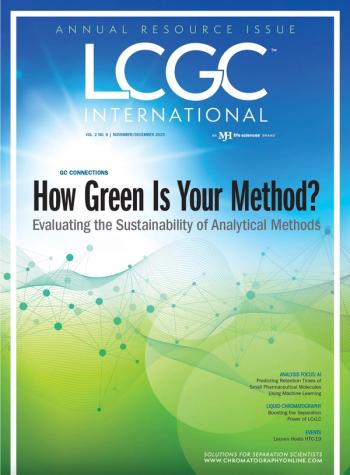
- The Application Notebook-06-01-2011
- Volume 0
- Issue 0
Method 525.2 Update: Analyte Recoveries with New CCL3 Compounds
EPA is updating method 525.2. The CCL3 includes 104 analytes. UCT has evaluated the recoveries of these compounds, including the current list, using proposed changes to the method with the C18-based UCT ENVIRO-CLEAN? 83 mL Extraction Cartridge ECUNI525.
Xiaoyan Wang, Michael Telepchak, Jeffery Hackett, and Don Shelly, UCT, LLC
EPA is updating method 525.2. The CCL3 includes 104 analytes. UCT has evaluated the recoveries of these compounds, including the current list, using proposed changes to the method with the C18-based UCT ENVIRO-CLEAN® 83 mL Extraction Cartridge ECUNI525.
Experimental
1) Sample Preparation
a) Weigh 0.1 g L-ascorbic acid, 0.35 g Na3EDTA and 9.4 g potassium monobasic citrate into a 1-L amber bottle.
b) Fill with sample water. Do not flush out preservation reagents.
c) Shake until salts dissolve.
d) Spike with surrogates and analyte standards. Mix well.
2) Sample Extraction
a) Assemble the extraction system. Attach adaptors, 525 cartridges, and bottle holders to 6-station manifold.
b) Wash the bottle holder and cartridge with 5 mL 1:1 EtOAc:MeCl2 (ethyl acetate: methylene chloride).
c) Draw half through, soak for 1 min then draw through remaining solvent. Dry under vacuum for 2 min.
d) Condition the cartridge with 10 mL MeOH. Soak for 1 min then draw most MeOH through, leaving a layer on the frit.
e) Add 10 mL of reagent water to the cartridge. Draw most of the water through the cartridge, leaving a layer on the frit.
f) Do NOT let the cartridge go dry, otherwise re-condition.
g) Place sample bottle on the bottle holder.
h) Turn on vacuum, adjust the flow to a fast drop-wise fashion.
i) After extracting sample, rinse the sample bottle by adding 10 mL reagent water. Pass rinse through cartridge.
j) Dry cartridge under full vacuum for 10 min.
Table I: Representative analyte recoveries data generated from spiked ground water
3) Sample Elution
a) Insert a 40-mL glass vial into the manifold.
b) Elute C18 cartridge with 5 mL EtOAc.
c) Draw half, soak 1 min then draw remaining through.
d) Repeat with 5 mL of MeCl2.
e) Add 10 g sodium sulfate (Na2SO4) to cartridge. Rinse bottle with 5 mL EtOAc then pour into cartridge.
f) Repeat using 5 mL MeCl2.
g) Remove extract. Dry through a 10-g bed of Na2SO4.
h) Rinse the Na2SO4 using both solvents.
i) Concentrate extract to 0.7 mL under a gentle N2 stream at 40 °C. Do NOT dry to ≤ 0.5 mL.
j) Quantitatively transfer extract to auto sampler vial then bring to 1 mL.
k) Add internal standards. Sample is ready for analysis.
4) Instrumentation
- GC–MS: Agilent 6890N GC with Chemstation software coupled with 5975C MSD & 7683 auto sampler
- GC capillary column: Restek Rxi-5sil MS 30 m × 0.25 mm × 0.25 µm
- Injector: 1 µL splitless injection at 250 °C, 1 min split delay
- Liner: 4 mm splitless gooseneck, 4 mm ID × 6.5 mm OD × 78.5 mm (UCT GCLGN4MM)
- Oven temperature program: Initial 55 °C, hold 1 min, ramp 10 °C/min to 200 °C, ramp 7 °C/min to 320 °C, and hold for 0.36 min. Total run time is 33 min. Begin data acquisition at 5 min.
- Carrier Gas: He 1.2 mL/min
- MSD condition: Aux temperature: 280 °C, MS Source: 230 °C, MS Quad: 150 °C
- Full scan: 45–500 amu
Conclusion
The UCT C18 ENVIRO-CLEAN® 83 mL Extraction Cartridge ECUNI525 has been shown to provide excellent recoveries for all Method 525 compounds as well as the EPA CCL3 analytes.
UCT, LLC
2731 Bartram Road, Bristol, PA 19007
tel. (800) 385-3153
E-mail:
Website:
Articles in this issue
over 14 years ago
Hydroxyethylstarches (HES)over 14 years ago
Aggregated Singletons for Automated Purification WorkflowNewsletter
Join the global community of analytical scientists who trust LCGC for insights on the latest techniques, trends, and expert solutions in chromatography.



